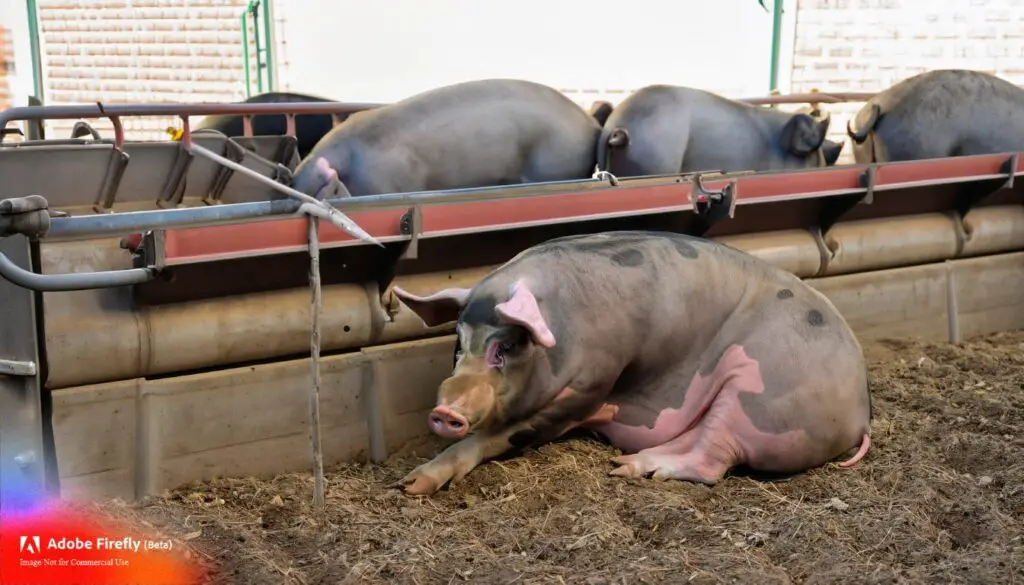
Moving pigs without a trailer can be done with careful planning and the right equipment. Here’s a step-by-step guide on how to move pigs without a trailer:
Materials You’ll Need:
- Secure fencing materials (panels, gates, or temporary fencing)
- A sturdy rope or pig harnesses
- Feed or treats to encourage movement
- Water source
- Assistance from at least one other person
Steps:
- Prepare a Temporary Enclosure:
- Before moving the pigs, set up a temporary enclosure in the destination area where you want to relocate them. Use secure fencing materials like panels, gates, or temporary fencing to create a safe and enclosed space.
- Check the Destination Area:
- Ensure that the destination area is suitable for the pigs, with access to food, water, and shelter.
- Plan the Route:
- Plan the route you’ll take to move the pigs to their new enclosure. Clear any obstacles or hazards along the way.
- Secure the Pigs:
- If your pigs are not already used to being led by a harness or rope, you may need to introduce them to the equipment gradually. Some pigs may be comfortable with a harness, while others may need a rope around their neck.
- Lead the Pigs:
- Gently lead the pigs towards the destination using the harness or rope. Be patient and move slowly, as pigs can be stubborn and may need some encouragement.
- Use Food as a Motivator:
- To encourage the pigs to move, use their favorite feed or treats as a motivator. You or your helper can walk ahead, holding the food, to entice them to follow.
- Have Assistance:
- It’s essential to have at least one other person to help with the pig-moving process. One person can lead the pigs, while the other can assist in case of any issues or to ensure they stay on the desired path.
- Maintain Safety:
- Ensure the safety of both the pigs and the people involved. Maintain a safe distance from the pigs’ hindquarters, as they can kick. Stay calm and avoid sudden movements.
- Check Water and Shelter:
- Once the pigs are in their new enclosure, check that they have access to fresh water and shelter. Pigs can become stressed during the move, so ensuring their basic needs are met is crucial.
- Monitor Adaptation:
- Keep an eye on the pigs as they settle into their new environment. They may need time to adjust to their new surroundings.
Moving pigs without a trailer can be a manageable task with the right equipment, assistance, and patience. It’s essential to prioritize the safety and well-being of the pigs throughout the process, making sure they have everything they need in their new enclosure.

Transporting Pigs: Loading and Moving
Transporting pigs is an essential part of pig farming, whether for market sales, relocation, or other reasons. Here are some tips for loading and moving pigs, along with the pros and cons of various transportation methods:
Tips for Loading and Moving Pigs:
1. Plan Ahead:
- Plan the transportation well in advance. Consider factors like distance, weather conditions, and the number of pigs to be transported.
2. Choose the Right Transportation Method:
- Depending on the distance and the number of pigs, you can choose between using a livestock trailer, pickup truck, or other suitable vehicles. Ensure the chosen method is appropriate for the specific journey.
3. Prepare the Transportation Vehicle:
- Clean and sanitize the vehicle before loading the pigs. Ensure it is well-ventilated and free from any sharp objects that could harm the pigs.
4. Use Proper Loading Equipment:
- Invest in or borrow appropriate loading equipment like ramps or chutes to make loading and unloading easier and less stressful for the pigs.
5. Handle Pigs Calmly:
- Approach the pigs calmly and avoid making loud noises or sudden movements. Stress can make the pigs difficult to handle.
6. Load Gradually:
- Load the pigs onto the transportation vehicle gradually, one or a few at a time. Be patient and avoid overcrowding, as it can lead to aggression and stress.
7. Secure the Pigs:
- Ensure that the pigs are securely confined within the vehicle to prevent injuries or escape during transportation.
8. Provide Adequate Ventilation:
- Ensure proper ventilation inside the transportation vehicle to prevent overheating and stress. Proper airflow is essential for the pigs’ comfort.
9. Monitor Temperature:
- Keep an eye on the temperature during transportation, especially in extreme weather conditions. Make adjustments as needed to keep the pigs comfortable.
10. Check Local Regulations: – Be aware of and comply with local regulations regarding the transportation of pigs, including legal weight limits, travel permits, and animal welfare standards.
Pros and Cons of Different Transportation Methods:
Livestock Trailer:
- Pros:
- Suitable for larger numbers of pigs.
- Provides better protection from the elements.
- Allows for separation of pigs if needed.
- Cons:
- Requires access to a livestock trailer.
- May not be cost-effective for small-scale farmers.
Pickup Truck:
- Pros:
- Suitable for small numbers of pigs.
- Easily accessible for many farmers.
- Cons:
- Limited space and ventilation.
- May not be suitable for long distances.
Pros and Cons of Loading Chutes:
Ramp/Chute:
- Pros:
- Facilitates easier loading and unloading.
- Reduces stress on pigs and handlers.
- Cons:
- Requires additional equipment and setup.
Manual Loading:
- Pros:
- No need for additional equipment.
- Cons:
- Can be more stressful for both pigs and handlers.
- Increases the risk of injuries to both.
How Do You Safely Move Pigs?
Here are some tips on how to safely move pigs:
- Use a trailer or truck that is specifically designed for transporting livestock.
- Make sure the trailer or truck is clean and dry.
- Provide plenty of ventilation in the trailer or truck.
- If you are transporting pigs for a long distance, stop every few hours to let them rest and eat.
- Be gentle when loading and unloading pigs.
- Never leave pigs unattended in a trailer or truck.
What Is Used To Transport Pigs?
Here are some of the things that are used to transport pigs:
- Livestock trailers: These are trailers that are specifically designed for transporting livestock. They typically have ramps that make it easy to load and unload pigs, and they have ventilation systems to keep the pigs cool and comfortable.
- Stock trucks: Stock trucks are trucks that have been modified to transport livestock. They typically have a divider that separates the pigs from the driver, and they have ventilation systems to keep the pigs cool and comfortable.
- Crates: Crates can be used to transport pigs over short distances. They should be large enough for the pigs to stand up and turn around comfortably.
How Do You Transport A Show Pig?
Here are some tips on how to transport a show pig:
- Start by getting the pig used to the trailer or truck. Let the pig explore the trailer or truck and sniff around.
- When you are ready to load the pig, be gentle and patient. Talk to the pig in a calm voice and offer it some food or water.
- Once the pig is in the trailer or truck, secure it in place. You can use a pig harness or a pig crate.
- Make sure the trailer or truck is well-ventilated.
- Stop every few hours to let the pig rest and eat.
- Be sure to bring plenty of water for the pig.
Are Pigs Afraid Of The Dark?
Pigs are not afraid of the dark. However, they do not like being in unfamiliar places or being alone. If a pig is scared, it may squeal, grunt, or try to escape.
Here are some of the things that pigs do when they are scared:
- Squeal
- Grunt
- Try to escape
- Pant
- Tremble
- Roll their eyes
Pigs should not be moved more often than necessary. Moving pigs can be stressful for them, and it can also increase the risk of injury. If you must move pigs, try to do it during the day and avoid moving them during hot or cold weather.
How Long Can A Pig Go Without Water and pooping?
Pigs can go without pooping for up to 3 days. However, it is not healthy for them to go without pooping for this long. Pigs should poop at least once a day.
Pigs can go without water for about 3 days. However, it is not healthy for them to go without water for this long. Pigs should have access to fresh water at all times.
Summary
In conclusion, careful planning and consideration of transportation methods are crucial when moving pigs. Each method has its pros and cons, and the choice should depend on factors like the number of pigs, distance, and available resources. Ensuring the pigs’ welfare and safety during transportation is of utmost importance.




![Why Do I Always Get Sick After Camping? [8 Reasons and Tips]](https://huntandlunch.com/wp-content/uploads/2023/09/9-1-768x768.jpg)

